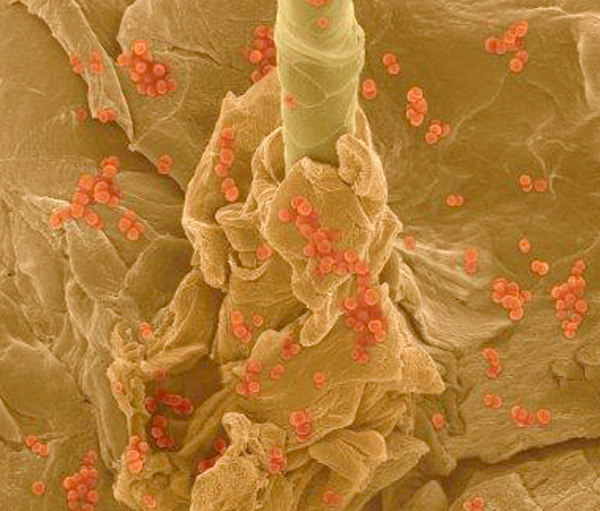
© Dennis Kunkel Microscopy
Home Resources Pathogens What is Staphylococcus aureus?
What is Staphylococcus aureus?

© Dennis Kunkel Microscopy
Staphylococcus aureus is a gram positive bacterium that usually appears under the microscope as spherical (coccus) organisms appearing in pairs, short chains, or bunched, grape-like clusters.
What diseases are caused by Staphylococcus aureus?
Staphylococcus aureus has been implicated as a causative agent in acute food poisoning episodes, toxic shock syndrome, impetigo, scalded skin syndrome, cellulitis, folliculitis and furuncles.
It is also a common cause of systemic infections such as infective endocarditis, osteomyelitis, epiglottitis, and sinus infections amongst others. S. aureus is also responsible for many infective and systemic infections in the health care setting (nosocomial infections).
Who is more susceptible to infections with Staphylococcus aureus?
All people are susceptible to infections with Staphylococcus aureus, the disease however, may manifest with varying intensities.
Epidemiology of Staphylococcus aureus
Staphylococcus aureus can cause illness by preformed toxin production as well as by infecting both local tissues and the systemic circulation. Disease transmission can occur in the following settings:
- Gastrointestinal: Staphylococcus aureus causes acute episodes of food poisoning via preformed enterotoxins. Food items likely to be infected by staphylococcal food poisoning include meat and meat products; poultry and egg products; salads such as egg, tuna, chicken, potato, and macaroni; bakery products such as cream-filled pastries, cream pies, and chocolate éclairs; sandwich fillings; and milk and dairy products.
- Skin and hair infections: Staphylococcus aureus commonly colonizes many skin surfaces on the nasopharynx, and perineum; but can cause infection of these surfaces particularly if the cutaneous barrier has been disrupted or damaged.
- Systemic infections: Staphylococcus aureus commonly causes infective endocarditis in IV drug abusers; osteomyelitis, sinus infections in the general population; and epiglottitis in young children.
- Nosocomial infections: Methicillin resistant Staphylococcal aureus (MRSA) is a strain of the bacteria that is commonly implicated in nosocomial infections. Risk factors for MRSA colonization or infection in the hospital settings include prior antibiotic exposure, admission to an intensive care unit, surgical incisions, and exposure to infected patients.
Incubation Period
Incubation Period for foodborne Staphylococcal aureus disease is 1-6 hours. Diagnosis Staphylococcal aureus gastrointestinal illness can be diagnosed by isolating the preformed toxins from the contaminated food item. Systemic infections are best diagnosed by blood cultures.
Treatment
Staphylococcal aureus are susceptible to beta-lactamase resistant penicillins such as ticarcillin and pipercillin. Vancomycin is the drug of choice for MRSA infections.
Contact EHA Consulting Group today for more information about how we can assist your company.
We offer services for
- Retail Food Safety
- Restaurant Food Safety
- Manufacturers
- Food Trucks
- Drugs & Cosmetics
- Melons & Cantaloupes
- Produce
- Warehouses
- Food Packaging & Packaging Materials